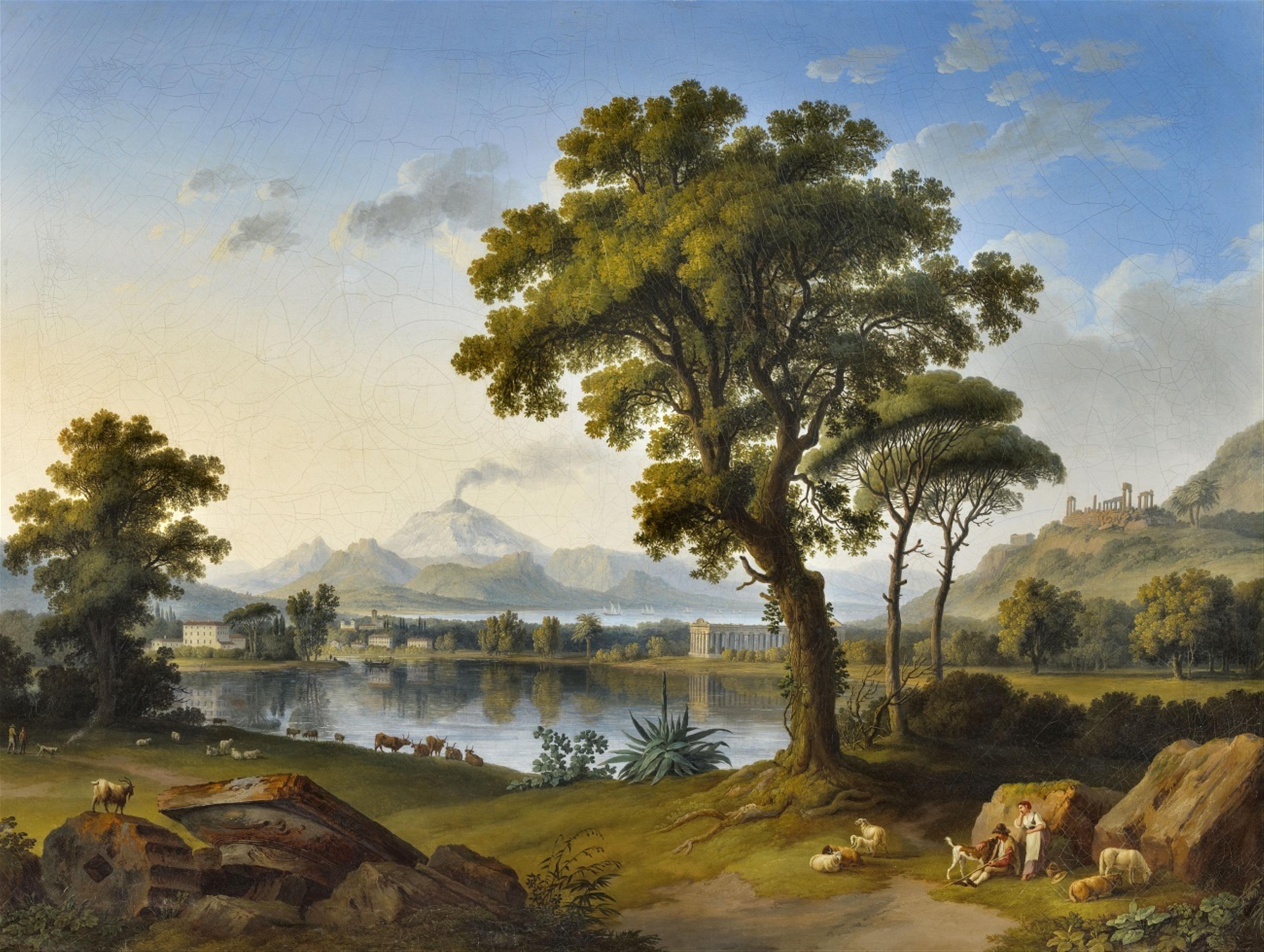Jacob Philipp Hackert
Landscape with Sicilian Temples
Oil on canvas (relined). 99.6 x 132.6 cm.
Signed and dated lower left: Ph. Hackert pinx: Roma 1779.
Jakob Philipp Hackert set off from Rome to southern Italy in 1777; the present work, depicting the classical monuments of Sicily in a panoramic landscape, was made two years after his return. The fine quality of the brushwork in this well-preserved piece shows an artist at the height of his prowess. Hackert's journey in 1777 took him to Paestum and Sicily, to Agrigento, Syracuse, Segesta, and Selinunte. He did not travel alone, but was accompanied by two English gentlemen, both wealthy, educated, artistically minded, and exceedingly enthusiastic. His travelling companions were the author, archaeologist and painter Charles Gore and Richard Payne Knight who, among his many other talents, was also the art theorist responsible for the coining of the term “picturesque” - a central topic of aesthetic discussion in 18th century England. Hackert, Gore, and Knight explored the ancient monuments together, with Hackert recording them in his watercolours (see fig. 1), whilst Gore and Knight made measurements and descriptions.
Johann Wolfgang von Goethe published Richard Payne Knight's travel journal in its entirety in his biography of Hackert. The journal is a fascinating document of the aesthetic wonder and rapture that repeatedly overcame the travellers at the sight of antique monuments so entirely different to the ones they had experienced in Rome. “Upon approaching, one is astonished by the view of the noble temple” Knight wrote of the building in Segesta, and of the temple of Juno Lacinia in Agrigento “the view of the temple of Juno is as picturesque as one could hope for”. The travellers were seized once again by a rapturous sensation when they ascended Mount Etna and looked down upon the sublimity of the landscape below: “The view (…) is beyond description or imagination (…) I feel elevated above humanity.”
Hackert depicts the ruins of the temple of Juno on a hill in the upper right of this work, with the temple of Segesta beside a large lake below it. In the background beyond the bay, we see a volcano that appears to be based on Mount Etna. Hackert combines the classical monuments in a landscape composition that cleverly draws the viewer's eye across a broad plane from one edifice to the other. The way in which Hackert uses the lake and the bay to create layers in the composition, the use of a single element - namely the large tree in the foreground - to create depth, and the manner in which the warm sunlight and depiction of shepherds evoke a pastoral, Arcadian vision of Italy all testify to the artist's great skill. At the time this work was painted, Hackert was living in Rome, and had already attracted numerous collectors throughout Europe.
The artist illustrates the monumentality of antiquity through the depiction of the temples themselves, but also in the rubble in the left foreground, using a diminutive goat to indicate the scale. The rubble functions as a repoussoir element, but is also symbolic of the newly discovered archaeological remains in southern Italy. The same motif appears again in Hackert's “Vues de la Sicilie” series of engravings published in 1786.
Depictions of Sicilian monuments seem to have exerted a strong fascination on contemporary collectors, and Hackert began to paint landscapes with single or grouped depictions of the island's ruins a year after his return. The images were the artist's own way of documenting his time in Sicily, and when the viewer lets his eye wander over these landscapes, he too seems to perceive a little of the overwhelming sensations felt by the artist on his trip.
Provenance
Auctioned by Christie´s, London, 30.11.1979, lot 63. - Galerie Scheidwimmer, Munich 1979. - Private collection, South Germany.
Literature
Claudia Nordhoff & Hans Reimer: Jacob Philipp Hackert 1737-180. Verzeichnis seiner Werke. Vol. II, p. 53f, no. 129, illus. 56.

